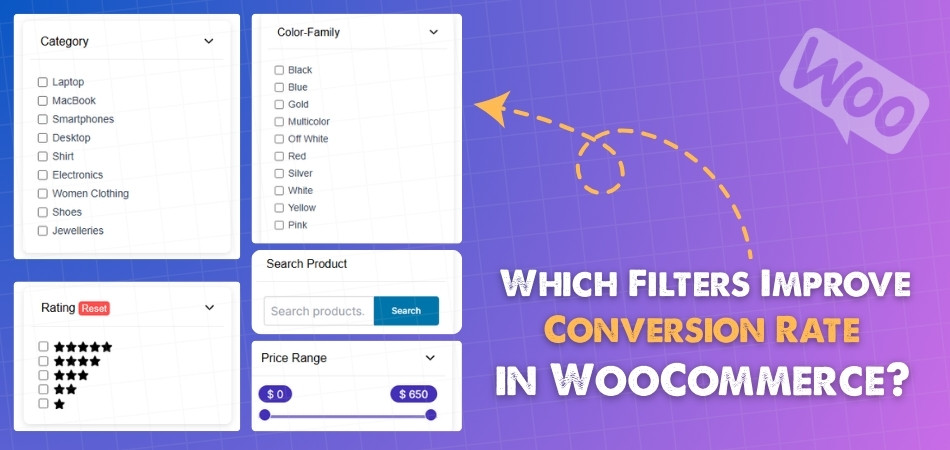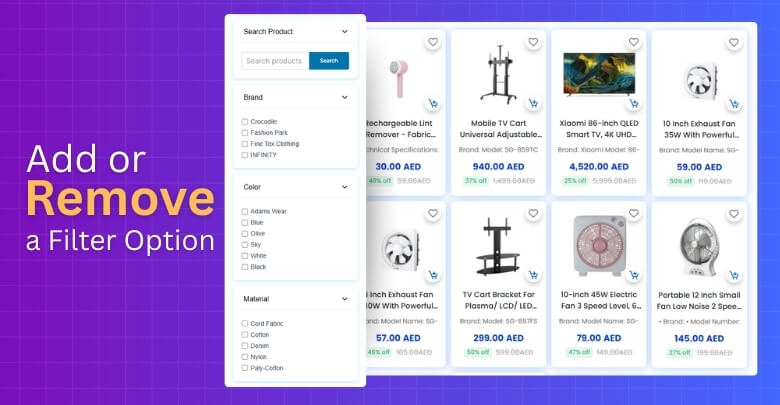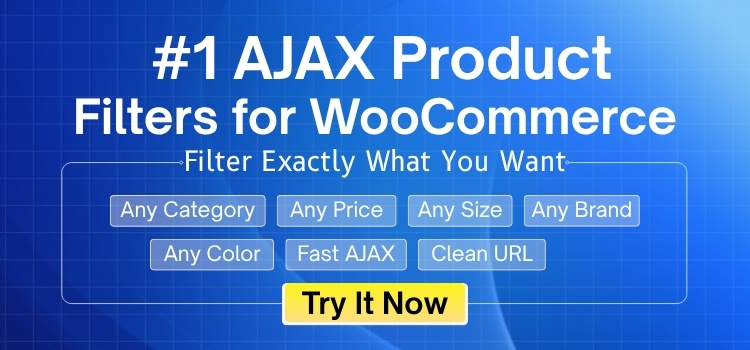Increasing the conversion rate in WooCommerce is one of the biggest goals for any online store. One smart way to do that is by using filters to help customers find what they want quickly. Filters make shopping smooth, clear, and fast. In this case, the site owner may ask: Which Filters Improve Conversion Rate in WooCommerce?
Filters that improve conversion rates in WooCommerce are price, attributes, categories, and ratings. A price filter helps shoppers stay within budget. Attribute filters allow choices like size, color, and brand. Category filters organize products into sections. Rating filters guide buyers toward trusted products. These filters save time and increase sales.
Do you want to know why these filters matter and how each one helps your store make more sales? If so, keep reading. The following section of this article covers everything you need to understand about filters and their role in boosting your WooCommerce conversion rate.
Which Filters Improve Conversion Rate in WooCommerce?
When people shop online, they often want to find what they need without wasting time. If a store has too many choices, it can feel confusing. This is where filters make the shopping process much smoother. Here are some useful filters that can help customers buy faster:

Price Filter
The price filter is one of the first tools people use when shopping online. Most shoppers already have a spending limit in mind. A price slider or range option lets them set a minimum and maximum budget easily. This helps them see only the products they can afford.
Using a price filter also saves time and keeps customers focused. They won’t waste effort looking at items that are too expensive or far below their budget. It also makes shopping feel more comfortable since people like staying within their range. This simple filter can lead to faster decisions and more sales.
Attribute Filter
Attribute filters allow people to choose details like size, color, or brand. This makes it easier for shoppers to find the exact match they are searching for. For example, someone may want a blue shoe in size 9. Instead of browsing endlessly, they can click a filter and find it quickly.
Without attribute filters, customers may get frustrated if they cannot locate what they want. They may even leave the store and search somewhere else. An Ajax product filter for WooCommerce makes this process faster by showing results instantly as customers adjust their choices. This improves their shopping experience and keeps them engaged.
Category Filter
Categories help organize the store in a way that is simple to explore. A person shopping for electronics doesn’t want to go through clothes or home items. With clear categories, they can jump straight to the section that interests them. This cuts down the confusion and makes browsing faster.
A clear menu also makes the store look neat and professional. Shoppers can move through the site without feeling lost. They know exactly where to find shoes, bags, or gadgets. This keeps them focused on buying instead of leaving the site.
Rating Filter
Ratings are important because they show trust from other buyers. Many people look at reviews before deciding to buy. A rating filter lets shoppers sort products from highest to lowest rated. This builds confidence in the items they are considering.
High-rated products are often linked with better quality and satisfaction. By showing these at the top, stores can encourage quicker purchases. Customers don’t have to spend extra time guessing which product is reliable. This simple filter can greatly influence their decision to buy.
Do All Filters Perform the Same on WooCommerce Sites?
No, not all filters perform the same in WooCommerce, because each filter has its own role in guiding customers. Price filters attract budget-conscious buyers, while attribute filters focus on style, brand, or size preferences that make choices faster. Category filters organize everything, and rating filters build trust by showing products that others liked, giving them a better chance.
Some filters, like price and attributes, directly affect the buying decision by quickly matching the shopper’s needs with product availability. Others, such as category filters, make the browsing experience easier, keeping the store neat and simple to move through. Ratings help shoppers trust a product, and they push sales by showing strong social proof from happy customers.
All filters are useful, but their impact differs depending on what the shopper is really looking for in that moment. Someone who cares about money will choose the price filter, while another shopper might look only at reviews. That means filters do not perform the same, but together they work strongly in boosting WooCommerce conversions overall.
How to Choose the Right Filters for Your WooCommerce Store?
Visitors to your online store should be able to find what they need quickly and easily. If they get confused or lost, they might leave without buying. That’s why filters matter a lot when setting up a WooCommerce store. Here is how to pick the best ones for your WooCommerce store.
Know Your Products
Start by understanding what kind of products you are selling. Are they clothes, electronics, furniture, or something else? Each type of product needs different filters to help customers find the right item. For example, clothing needs size and color filters, while electronics need brand and feature filters. Picking filters that match your product type makes everything more useful.
Think Like a Buyer
Try to imagine what a shopper will do when they come to your store. What will they search for first? Maybe it’s the price, color, or customer rating. Use filters that match what people care about the most. This makes the shopping experience smoother and helps them stay longer.
Use Important Filters
Not every filter needs to be used. Stick to the ones that help the most, like price, category, brand, and rating. These are usually the ones buyers use before they even look at a product. Keep things simple so the store feels clean and easy to browse. Too many filters can confuse people.
Avoid Repeating Filters
Sometimes stores repeat the same filters in different ways, which can clutter the page. Don’t use two filters that show the same thing. For example, “T-shirt” and “Topwear” may feel different but mean the same thing. Keep the options clear, so shoppers don’t feel lost or unsure. Simple filters work better.
Match Filter Style
Your filter style should match your store’s look. Use clean layouts like dropdowns, sliders, or color swatches where they fit best. Make sure the filters are easy to spot but not too big or flashy. A good layout keeps people focused on shopping, not figuring out how things work.
Check Filter Results
Once you add filters, test how they work with your products. Make sure no filter gives empty results or wrong products. In many cases, large WooCommerce store filter performance can drop if filters are not well set or optimized. If a size or color option shows nothing, that’s a problem. Fix or remove filters that don’t work.
When to Add or Remove a Filter Option?
Online stores often change as products and customer needs change. Filters are not something you set once and forget. Knowing when to add or remove them makes the store easier to use. Let’s look at both cases in detail.

When to Add Filters
Based on Product Range
As your product range grows, new filters may be needed. A clothing store with multiple sizes must add a size filter. Without it, buyers may leave because they cannot find the right fit. Adding filters ensures shoppers quickly reach what they want. Filters should always match the variety of products you offer.
Watching Customer Behavior
Customer actions show you what filters are missing. If many shoppers search for color or material, add those filters. This makes their shopping smoother and saves time. Always pay attention to what people are searching for most. Regularly checking customer activity helps you keep filters relevant.
Seasonal Demands
Some products need seasonal filters. During festivals, adding a color filter for festive shades can help. For summer, adding filters like fabric type may matter. These temporary filters can improve customer experience during specific times. Once the season ends, you can remove or replace them.
Testing New Options
Sometimes testing a new filter helps you understand buyer interest. For example, adding a “bestseller” filter can highlight trending products. If customers use it, keep it active. If they ignore it, remove it later. Testing filters helps you stay updated with your shopping habits.
When to Remove Filters
Avoiding Empty Results
Filters that show zero products frustrate buyers. If size or color is out of stock, remove that filter for now. This keeps shoppers from wasting time. Add it back once stock is available again. Always make sure every filter leads to useful results.
Improving Store Speed
Too many filters can slow your site. Heavy or unused filters affect loading speed and hurt the shopping experience. Remove the ones that make browsing slow. A fast store always makes customers happier. Store performance should never be sacrificed for extra filters.
Matching Popular Choices
Not all filters get equal attention. If customers use brand filters more than price filters, reduce the less-used ones. This clears clutter and keeps focus on what buyers really care about. Remove filters that no longer add value. Stick with the ones that are truly helpful.
Keeping Store Clean
Having too many filters can confuse shoppers. Duplicates or unnecessary options make the store look messy. Remove filters that repeat the same choices. A clean layout makes the shopping experience simple and enjoyable. Organized filters give a store a professional and easy look.
Do Filters Affect WooCommerce Site Speed?
Yes, filters can affect WooCommerce site speed depending on how many are used and how they are managed. Extra filters increase server requests, which can slow down the loading time of product pages. Shoppers often leave when sites load slowly, causing lost sales. A well-optimized site with balanced filters will perform much faster and provide a better shopping experience overall.
Too many active filters running together often create unnecessary pressure on your store’s database. This is especially noticeable when managing larger product catalogs. Every additional filter demands resources, making the store less responsive and frustrating for customers. Keeping filters simple and efficient helps maintain site speed without reducing shopping convenience.
Removing unused filters, optimizing existing ones, and using lightweight plugins can improve performance. Store owners must always balance usefulness and speed. A faster website gives customers confidence, while filters without slowing down store encourage them to browse more products. Smart choices about filters ensure WooCommerce stores remain quick and effective for better conversions.
Best Practices for Optimizing WooCommerce Filters
A smooth shopping experience depends on how well filters work inside your WooCommerce store. Poorly optimized filters can confuse buyers and slow pages. When filters are set up correctly, they make product searches simple and clear. Let’s look at the best practices to keep filters effective.

Clear Filter Names
Filter names must be short, clear, and easy to understand. Shoppers should not waste time figuring out what each filter means. Using simple words like “Brand,” “Material,” or “Style” makes things more direct. Clear names help customers feel confident while searching.
Limit Filter Count
Too many filters can overwhelm shoppers instead of helping them. Stick to the filters that add the most value. Having fewer but meaningful options creates a cleaner layout. This approach keeps the store neat and easy to use.
Place Filters Smartly
The position of filters affects how shoppers use them. Filters work best when placed on the left sidebar or top bar. Easy placement helps customers notice them quickly. If filters are hidden, people might skip using them completely.
Use Icons or Swatches
Filters are not only about words. Adding icons or color swatches makes them more attractive and easier to pick. For example, color swatches are more visual than a simple list of names. Visual filters improve customer experience by saving time.
Make Filters Mobile-Friendly
Many buyers shop from mobile devices, so filters must work well on small screens. Use dropdowns or collapsible sections for easy access. Avoid long scrolling lists that take too much space. Mobile-friendly filters help buyers stay engaged without frustration.
Update Filters Regularly
Filters should match product updates in your store. If new features or categories are added, filters should change too. Keeping them updated ensures accuracy and better usability. This is a simple but effective way to optimize WooCommerce filters.
Check Analytics Data
Data shows which filters people use the most. Tracking this helps store owners adjust filters to match customer needs. Less-used filters can be removed or replaced. Analytics makes filter optimization smarter and more effective over time.
Frequently Asked Questions
Filters serve as more than just tools for reducing the number of options in WooCommerce. They play a big role in how customers shop, make decisions, and eventually complete purchases. Below are some common questions with detailed answers that will give you extra insights into filters and their impact on conversion rates.
How Do Filters Influence Buying Confidence?
Filters influence buying confidence by making the shopping process easier and more predictable. When customers can quickly see items that match their needs, they feel assured they are not wasting time. This confidence builds trust in the store, which leads to higher chances of completing a purchase.
Why Is Filter Design Important for Conversions?
The design of filters matters because customers interact with them directly during product searches. A clean, simple design makes filters more user-friendly and less confusing. When filters are easy to spot and use, customers are more likely to continue browsing and eventually make a purchase.
Do Filters Reduce Bounce Rate in WooCommerce?
Yes, filters help reduce bounce rate because they keep customers engaged. Shoppers who cannot find products quickly often leave the store early. With filters that make searching simple, customers stay longer, explore more products, and have a better chance of converting into buyers.
How Can Filters Improve Product Discovery?
Filters improve product discovery by showing customers items they might not have found on their own. For example, someone searching for a red bag may also find a similar color or style. This opens up more choices and increases the chances of extra sales.
Do Visual Filters Impact Conversion Rates?
Visual filters such as color swatches, size icons, or product images can strongly impact conversions. These filters make the shopping process more interactive and engaging. By making filters easier to understand visually, stores encourage quicker decisions and reduce hesitation, leading to more completed purchases.
Why Should Filters Be Tested Regularly?
Filters should be tested regularly to make sure they are delivering accurate results. Over time, products change, categories expand, and customer needs shift. Testing ensures that filters are still useful and effective. Well-maintained filters improve customer satisfaction and boost conversion rates.
Why Are Location-based Filters Important?
Location-based filters allow customers to see products available in their region or within certain shipping options. These filters reduce the chances of disappointment if a product is not deliverable. By saving time and setting clear expectations, they help increase customer trust and conversion rates.
Conclusion
Filters are not just tools for sorting products; they are the secret to making shopping simple and enjoyable. When used wisely, they guide customers straight to what they want, saving time and reducing frustration. A smooth shopping experience often turns into higher sales.
Understanding which filters improve conversion rate in WooCommerce helps you focus on what truly matters. Price, attributes, categories, and ratings are more than features; they are powerful elements that build trust and speed up buying decisions. Choosing the right mix ensures your store feels professional and easy to shop.
As your store grows, keep testing and refining your filters to match customer needs. Smart filters create confident shoppers, and confident shoppers are more likely to buy. A well-optimized filter system can be the difference between browsing and converting.
